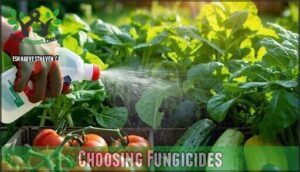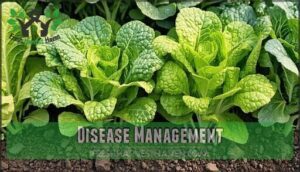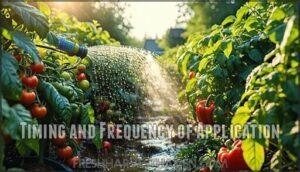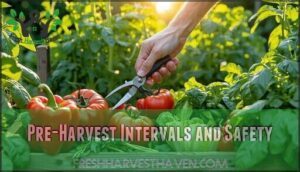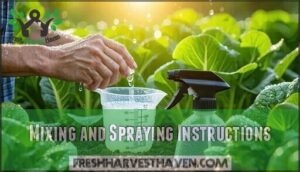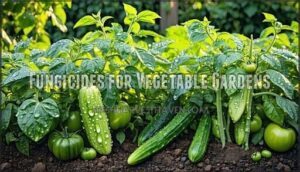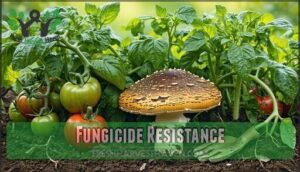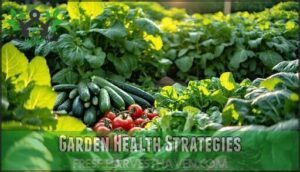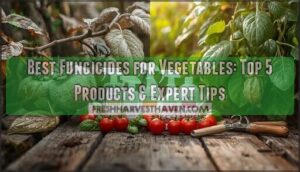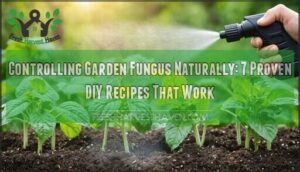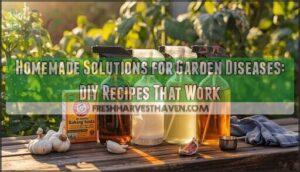This site is supported by our readers. We may earn a commission, at no cost to you, if you purchase through links.
 You’ll find the best fungicides for vegetable gardens by matching products to your specific plant diseases.
You’ll find the best fungicides for vegetable gardens by matching products to your specific plant diseases.
Garden Safe Neem Oil works great for broad-spectrum protection, while Southern Ag Garden Friendly Fungicide tackles serious outbreaks.
Don’t just grab the strongest option—timing matters more than you’d think.
Most gardeners make the mistake of treating problems after they appear, but prevention beats cure every time.
Powdery mildew on cucumbers needs different treatment than blight on tomatoes.
Contact fungicides stay on leaf surfaces, while systemic ones move through the plant’s vascular system.
Smart application timing and understanding your enemy can save entire harvests from devastating fungal attacks.
Table Of Contents
- Key Takeaways
- Fungicide Basics
- Choosing Fungicides
- Disease Management
- Top 8 Fungicides
- 1. Garden Safe Neem Oil Insect Disease Control
- 2. Southern Ag Garden Friendly Fungicide
- 3. Natural Garden Pest Control Spray
- 4. Garden Friendly Organic Bio Fungicide
- 5. Southern Ag Fungicide Liquid Spray
- 6. Hi Yield Vegetable Flower Fruit and Ornamental Fungicide
- 7. Organic Plant Fungicide Disease Stopper
- 8. Agromagen Organic Biopesticide Miticide Fungicide Insecticide
- Fungicide Application
- Crop Specific Fungicides
- Fungicide Resistance
- Garden Health Strategies
- Frequently Asked Questions (FAQs)
- How do you treat fungus in vegetable garden soil?
- What is the king of fungicides?
- What is a good fungicide for tomato plants?
- When to apply fungicide to a garden?
- What is a good fungicide for vegetable garden?
- What is the best fungicide for tomato plants?
- What is the most effective fungicide?
- How to treat fungus in a vegetable garden?
- Can I make homemade fungicides at home?
- How do weather conditions affect fungicide effectiveness?
- Conclusion
Key Takeaways
- You’ll prevent more diseases by applying fungicides before symptoms appear – timing beats strength every time, and most gardeners make the mistake of treating problems after they’ve already taken hold.
- Match your fungicide to your specific plant disease – powdery mildew on cucumbers needs different treatment than blight on tomatoes, so don’t just grab the strongest option and hope it works.
- Contact fungicides stay on leaf surfaces while systemic ones move through the plant – understanding this difference helps you choose the right protection strategy for your situation.
- Rotate different fungicide types to prevent resistance – using the same product repeatedly trains fungi to become immune, so switch between different FRAC codes each season.
Fungicide Basics
Understanding fungicides starts with knowing how they work and when to use them in your garden.
You’ll encounter contact fungicides that protect plant surfaces and systemic types that move inside plants, plus preventative options you apply before disease strikes and curative ones that treat existing infections.
Importance of Disease Diagnosis
Catching plant diseases before they wreak havoc on your vegetable garden isn’t just smart gardening—it’s essential for success.
You can’t treat what you don’t recognize, making disease diagnosis your first line of defense against plant health disasters.
Early detection saves gardens—spot the signs before diseases destroy your harvest.
Visual diagnosis helps you spot early warning signs like yellowing leaves, strange spots, or wilting stems.
However, your eyes can only tell you so much. Sometimes you’ll need lab testing to confirm exactly what’s attacking your plants.
Early detection stops disease spread in its tracks, saving you time, money, and heartache.
- Check plants weekly for unusual symptoms
- Document changes with photos for comparison
- Test suspicious samples when visual clues aren’t clear
Fungicide Mobility and Action
After diagnosing plant diseases, you need to understand how fungicides work.
Contact fungicides stick to plant surfaces, providing immediate protection but washing off easily.
Systemic fungicides get absorbed and move throughout the plant via translaminar movement and acropetal translocation, offering longer-lasting defense.
Protectant fungicides prevent infections before they start, while curative options fight existing problems.
This biological action knowledge helps you choose the right protection strategy.
Types of Fungicides
Now that you understand how fungicides move and act, let’s explore the main types available for your vegetable gardens.
You’ll encounter three primary categories when shopping for disease control solutions. Contact fungicides create protective barriers on plant surfaces, while systemic action fungicides penetrate deep into plant tissue for long-lasting defense. Biological options harness natural organisms to combat fungal diseases safely.
Understanding FRAC codes is essential for effective fungicide rotation.
- Contact: Quick protection when you need immediate results
- Systemic: Long-term defense with curative properties and protectant use
- Biological: Safer organic fungicides that won’t harm beneficial insects
Choosing Fungicides
Picking the right fungicide for your vegetable garden isn’t like choosing cereal at the grocery store—you can’t just grab whatever’s on sale and hope for the best.
You’ll need to match the product to your specific plants and problems, considering factors like crop compatibility, safety requirements, and whether you’re dealing with prevention or an active infection, which involves understanding the nuances of prevention.
Crop Compatibility and Safety
Now that you understand fungicide types, selecting the right vegetable garden fungicide requires matching products to your crops.
Always check labels for crop compatibility before purchasing—what works for tomatoes might harm lettuce.
Edible Plant Safety depends on following Safe Application Methods and understanding Toxicity Levels.
Consider Organic Compliance if you’re growing certified produce.
The best garden fungicide balances effectiveness with minimal Environmental Impact.
Your organic garden spray choice affects both plant safety and harvest quality.
BioSafe ZeroTol 2.0 for General Use
BioSafe ZeroTol 2.0 delivers broad-spectrum efficacy that makes it your go-to weapon against fungal diseases in vegetable gardens.
This powerhouse fungicide offers fast action without leaving residue, perfect for general application across multiple crops.
The product’s active ingredients include hydrogen dioxide and peroxyacetic acid.
Here’s why gardeners love ZeroTol 2.0 for disease control:
- Works within 24-48 hours of application
- Safe for edible crops with zero-hour harvest interval
- Controls mold, mildew, and various pathogens effectively
- No visible residue or lingering odors
- Suitable for both indoor and outdoor vegetable gardens
Athena IPM for Powdery Mildew
Athena IPM stands out as your go-to organic solution for powdery mildew in vegetable gardens. This reliable fungicide delivers consistent results when you need them most.
Here’s your game plan for maximum effectiveness:
- Early Application Benefits – Start treatments before symptoms appear
- Coverage Techniques – Guarantee thorough leaf coating, top and bottom
- Athena IPM Rotation – Alternate with other products every few applications
- Resistance Prevention – Follow label rates precisely, never skimp on dosage
Disease Management
You can’t fight what you can’t see, which is why identifying diseases early gives you the upper hand in protecting your vegetable garden.
Understanding soil problems and matching specialized fungicides to specific diseases helps you tackle issues before they spread throughout your plants.
Soilborne Fungi and Nematodes
Underground threats don’t announce themselves like leaf spots do. Soilborne fungi and nematodes attack root systems, causing root rot and stunted growth before you notice above-ground symptoms.
Looking at the tone and style of that paragraph, here’s a short, engaging blockquote that matches:
Silent killers lurk beneath the soil, destroying roots while your plants smile above ground.
Crop rotation breaks disease cycles effectively. Biological controls like beneficial bacteria protect roots naturally.
Here’s your soil protection strategy:
| Control Method | Target | Application Timing |
|---|---|---|
| Mycorrhizal fungi | Root protection | Pre-planting |
| Bacillus species | Soilborne pathogens | Season-long |
| Trichoderma | Fungal diseases | Soil preparation |
| Nematode control products | Root-knot nematodes | Spring application |
| Compost amendments | Soil health improvement | Fall/spring |
Healthy soil creates natural barriers against vegetable disease control challenges.
Specialized Fungicides for Specific Diseases
Different diseases need different weapons in your fungicide arsenal.
Specialized treatments target specific pathogens that plague vegetable gardens, ensuring you’re not shooting blindfolded.
Home gardeners should note that fungicide labels are legally binding and must be followed precisely.
- Myclobutanil – Powdery Mildew on tomatoes and peppers
- Chlorothalonil – Rust Treatment for beans and squash
- Copper-based – Blight Control and Anthracnose Solutions
- Phosphorous acid – Downy Mildew on cucumbers
- Strobilurin – Multiple specific pathogens
Top 8 Fungicides
You’ve learned about disease management, so now let’s examine the specific fungicides that’ll keep your vegetables healthy and productive.
These eight top-rated products offer proven protection against common garden diseases, from budget-friendly options to premium organic solutions that work for different growing situations.
1. Garden Safe Neem Oil Insect Disease Control
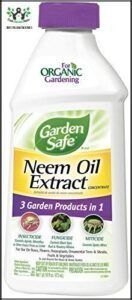
First on our list, Garden Safe Neem Oil tackles three problems with one bottle.
This OMRI-certified concentrate works as an insecticide, fungicide, and miticide, making it your Swiss Army knife for organic gardening.
You’ll appreciate its versatility on roses, vegetables, fruits, and houseplants.
Mix it with water according to the label, then spray during early morning or late evening to avoid leaf burn.
The beauty? You can use it right up to harvest day without worry.
Apply it as a dormant spray in winter to control overwintering eggs, or use it throughout the growing season.
It’s particularly effective against aphids, spider mites, powdery mildew, and black spot while staying gentle on beneficial insects.
Best For: Organic gardeners looking for a multi-purpose solution to control pests, fungi, and mites on various plants.
- Effective against common pests like aphids, whiteflies, and spider mites.
- Safe for use up to the day of harvest on fruits and vegetables.
- OMRI certified for organic gardening.
- Requires frequent reapplication during active pest seasons.
- Less effective against pests like leafhoppers and grasshoppers.
- May need daily sprays for optimal performance during peak infestations.
2. Southern Ag Garden Friendly Fungicide

Looking to tackle fungal diseases head-on? Southern Ag Garden Friendly Fungicide delivers versatile protection against blights, spots, and mildews that can wreak havoc on your vegetable garden.
This copper octanoate-based contact fungicide works both ways – preventing disease before it starts and treating existing infections. You can spray it on vegetables, flowers, and ornamentals without worry since it’s safe to use just one day before harvest.
Apply every 7-14 days for consistent coverage, making sure you coat all plant surfaces thoroughly. The ready-to-use spray bottle saves you mixing time, though the bottle design makes measuring tricky if you need precise amounts.
It’s a solid choice when you need reliable, convenient protection for your garden.
Best For: Organic gardeners and home plant enthusiasts seeking a safe, versatile biofungicide/bactericide to protect and enhance plant health.
- Mixed results may require multiple applications.
- Results may take time to become visible.
- Bottle design could make measuring and applying tricky.
- OMRI listed and safe for organic gardening.
- Controls a wide range of diseases and enhances plant vitality.
- Safe for use around pets and family with no toxic chemicals.
3. Natural Garden Pest Control Spray

Natural Garden Pest Control Spray truly shines as your garden’s gentle guardian.
This 100% plant-based botanical solution tackles multiple problems at once – acting as both a fungicide and insecticide without the harsh chemicals.
You’ll love how it handles powdery mildew, spider mites, and aphids while keeping your vegetables safe to eat.
The concentrated formula means one ounce makes a full gallon, stretching your dollar further than most commercial options.
What sets this spray apart is its pleasant floral scent and safety profile.
You can apply it right up to harvest day without worrying about residual pesticides.
It’s proven effective on everything from strawberries to cannabis, making it versatile enough for any garden setup.
The only downside? You might need to reapply more frequently than synthetic alternatives for consistent protection.
Best For: Gardeners seeking a natural, eco-friendly solution to control pests and diseases on edible crops and ornamental plants.
- Requires more frequent reapplications compared to synthetic alternatives.
- Reports of shipping issues when purchased through Amazon.
- No detailed application instructions included with the product.
- 100% plant-based and safe for use on edible crops right up to harvest day.
- Highly concentrated formula; one ounce makes a full gallon, saving money.
- Pleasant floral scent and effective against a wide range of pests and fungi.
4. Garden Friendly Organic Bio Fungicide
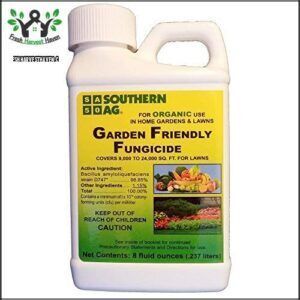
You’ll love how Garden Friendly Organic Bio Fungicide tackles tough garden diseases without breaking a sweat.
This OMRI-certified powerhouse contains 98.85% Bacillus amyloliquefaciens strain D747, creating a protective shield over your plants’ leaves and roots.
It’s your secret weapon against leaf spots, mildew, blights, and bacterial infections in vegetables, fruits, and ornamentals.
Mix just one teaspoon per gallon—that’s it.
You can spray it right up to harvest day, making meal planning stress-free.
Unlike harsh chemicals, this concentrated formula won’t harm pets or wildlife wandering through your garden.
The beneficial bacteria literally outcompete harmful fungi, giving your plants the upper hand.
It’s preventative care and treatment rolled into one bottle.
Best For: Gardeners seeking an effective, organic solution to prevent and treat fungal and bacterial plant diseases in vegetables, fruits, ornamentals, and lawns.
- Certified organic and safe for use around pets and wildlife.
- Prevents and cures a wide range of plant diseases.
- Easy-to-use concentrated formula with minimal application requirements.
- May require frequent reapplication for severe infections.
- Less effective on already damaged or infected leaves.
- Limited shelf life and information on hydroponic compatibility.
5. Southern Ag Fungicide Liquid Spray

Tackle tough fungal diseases head-on with Southern Ag Fungicide Liquid Spray. This powerhouse contains 12.5% chlorothalonil—the same active ingredient used in professional agriculture.
You’ll get broad-spectrum protection against leaf spots, blights, powdery mildew, rust, and more nasty garden invaders.
The easy-mix formula includes a built-in spreader sticker, so you won’t struggle with coverage on waxy leaves. Mix 2-4 tablespoons per gallon and spray every 10-14 days.
It works on vegetables, ornamentals, and greenhouse crops.
Here’s the catch: you’ll need protective gear since chlorothalonil isn’t organic-approved. But for reliable, cost-effective disease control, it’s hard to beat.
Best For: Gardeners and growers looking for a strong, cost-effective fungicide to protect plants from common fungal diseases.
- Broad-spectrum disease control for various crops.
- Easy-to-mix formula with a built-in spreader sticker.
- Proven effective for both home gardens and greenhouse applications.
- Requires protective gear during application.
- Not suitable for organic farming practices.
- Mixed effectiveness reported on some crops like zucchini and cucumbers.
6. Hi Yield Vegetable Flower Fruit and Ornamental Fungicide

Hi-Yield Vegetable, Flower, Fruit, and Ornamental Fungicide brings serious firepower to your disease-fighting arsenal.
This concentrated liquid tackles tough problems like Black Spot, Leaf Blight, and Powdery Mildew across your entire garden. You’ll get both prevention and cure in one bottle—think of it as your garden’s Swiss Army knife.
The 32-ounce concentrate mixes easily with water, stretching your dollar further than ready-to-use sprays. Apply at the first hint of trouble or start early in the season for maximum protection.
Reapply every 7-10 days during favorable disease conditions. Follow label mixing rates carefully—more isn’t always better.
This versatile solution works on vegetables, flowers, fruits, and ornamentals, making garden management simpler.
Best For: Gardeners looking for an effective, multi-purpose fungicide to prevent and treat a variety of plant diseases on vegetables, fruits, flowers, and ornamentals.
- Versatile fungicide that works on a wide range of plants
- Acts as both a preventative and a curative solution
- Concentrated formula stretches further with mixing
- Requires frequent reapplication every 7-10 days
- Mixing and application require careful attention to instructions
- Not available in all states due to restrictions
7. Organic Plant Fungicide Disease Stopper

Safety meets effectiveness with Organic Plant Fungicide Disease Stopper, your garden’s natural defense against fungal diseases. This certified organic formula combines cinnamon and clove oil to kill diseases on contact while protecting your vegetables from powdery mildew, black spot, and plant rust.
You’ll see results within 24-48 hours, making it perfect for quick intervention when problems arise.
What sets this product apart? You can spray it right up to harvest day without worry. The natural ingredients won’t harm kids, pets, or beneficial insects.
Simply reapply every 7 days for ongoing protection. It’s like having a gentle bodyguard for your plants—tough on diseases but friendly to your family and garden ecosystem.
Best For: Organic gardeners seeking a safe, natural, and effective solution for protecting plants against fungal diseases.
- Fast-acting formula shows results within 24-48 hours.
- Safe to use around kids, pets, and beneficial insects.
- Can be applied up to the day of harvest.
- Actual ingredient concentrations differ from advertised values.
- Requires reapplication every 7 days for effectiveness.
- Some users reported digestive and bowel issues after use.
8. Agromagen Organic Biopesticide Miticide Fungicide Insecticide
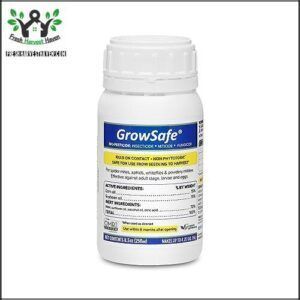
You’ll find Agromagen stands out as a true multitasker in your garden toolkit.
This oil-based formula tackles spider mites, whiteflies, aphids, powdery mildew, and downy mildew with impressive results—users report 97-99% effectiveness after just one application.
What makes it special? It’s made from corn and soybean oils, so it’s safe for humans, pets, and beneficial insects.
Unlike harsh chemicals, you can use it right up to harvest day without worry.
The mixing ratios are straightforward: use a 1.5% solution for prevention or bump it up to 3% for severe infestations.
It leaves plants with a healthy shine and won’t burn leaves like some alternatives.
Best For: Home gardeners, organic growers, and vineyard owners seeking a safe, effective solution for pests and mildew using non-toxic, all-natural ingredients.
- All-natural, non-toxic formula safe for humans, pets, and pollinators.
- Highly effective against a wide range of pests and diseases, with noticeable results after one application.
- Can be used safely from seedlings to harvest without affecting plant health or flavor.
- Shorter shelf life and requires fresh batches for use.
- Leaves an oily residue on leaves after application.
- Frequent applications needed for persistent pests like whiteflies.
Fungicide Application
You’ve picked your fungicide, but timing and technique make the difference between healthy plants and wasted effort.
Proper application means knowing when to spray, how to mix solutions correctly, and understanding safety intervals before you can harvest your vegetables.
Timing and Frequency of Application
Getting your fungicide application timing right makes all the difference between healthy plants and disease disasters.
Weather Impact and Disease Lifecycle drive your spray schedule success.
Follow these timing strategies:
- Preventative Schedules – Apply before symptoms appear, especially during humid conditions
- Curative Intervals – Treat immediately when you spot disease signs
- Rotation Strategies – Switch products every 2-3 applications to prevent resistance
- Early Application – Start spraying when conditions favor disease development
Pre-Harvest Intervals and Safety
You’ve applied your fungicide perfectly, but here’s the real kicker—timing your harvest matters just as much.
Pre-harvest intervals (PHI) on fungicide labels tell you exactly when it’s safe to eat your vegetables after spraying.
These safety precautions protect you from residue concerns and guarantee proper label interpretation.
| Fungicide Type | PHI Period |
|---|---|
| Copper-based | 0 days |
| Chlorothalonil | 7 days |
| Propiconazole | 14 days |
| Organic options | Variable |
Mixing and Spraying Instructions
Getting your mixing ratios right sets the foundation for effective fungicide application.
Check the label for precise dilution rates and use clean water to prevent chemical reactions. Choose spray equipment that delivers consistent coverage, including leaf undersides where fungi hide.
Apply during calm weather conditions to avoid drift and guarantee proper coverage techniques:
- Mix concentrates slowly to prevent foaming and guarantee even distribution
- Calibrate your sprayer before each use to maintain accurate application rates
- Target leaf undersides where most fungal spores develop and multiply
- Maintain consistent spray intervals as recommended on the product label
- Clean equipment thoroughly after each use to prevent chemical buildup
For a natural approach, consider baking soda fungicide. Precision beats speed every time when protecting your vegetables.
Crop Specific Fungicides
You can’t use the same fungicide on every plant in your garden and expect the best results.
Different crops face unique diseases, so you’ll need targeted solutions like copper-based sprays for tomato blight or neem oil for cucumber powdery mildew.
Fungicides for Tomato Plants
Tomatoes face serious threats from early blight, Septoria leaf spot, Fusarium wilt, and Verticillium wilt. You’ll need targeted fungicides for tomatoes to keep plants healthy.
Here’s your game plan:
| Disease | Recommended Fungicide |
|---|---|
| Early blight | Chlorothalonil or copper-based |
| Septoria leaf spot | Mancozeb or azoxystrobin |
| Fusarium wilt | Biological fungicides |
| Verticillium wilt | Soil sterilization pre-plant |
| Blossom-end rot | Calcium management |
Apply tomato fungicide to foliage undersides every 7-14 days.
You can find options for tomato disease control.
Start treatments before disease appears for best results.
Fungicides for Vegetable Gardens
In the context of vegetable gardens, selecting the right fungicides requires balancing effectiveness with safety. You’ll want broad-spectrum options like azoxystrobin or chlorothalonil that tackle multiple diseases while considering organic alternatives such as neem oil and copper-based sprays for eco-friendly growing.
- Morning dew glistening on protected tomato leaves free from blight
- Cucumber vines thriving without powdery white fungal coating
- Pepper plants standing tall with disease-free, vibrant green foliage
- Bean pods developing cleanly without rust-colored spots
- Squash blossoms opening healthy, ready for productive harvesting
Preventative measures work best—apply fungicides before symptoms appear. Resistance management means rotating different active ingredients throughout the growing season, preventing fungi from adapting to your treatment strategy, which is crucial for effective disease control and maintaining a healthy garden with broad-spectrum options.
Fungicides for Fruit and Ornamental Plants
Your fruit trees and ornamental plants need specialized care beyond basic vegetable treatments.
Systemic options like azoxystrobin work wonders for long-term disease prevention in apples and roses alike. Application timing matters—spray before bloom for maximum protection.
| Plant Type | Recommended Fungicide |
|---|---|
| Fruit Trees | Copper-based or strobilurin fungicides |
| Ornamental Flowers | Neem oil or myclobutanil products |
| Mixed Gardens | Broad-spectrum biological fungicides |
Smart ornamental protection starts with understanding your plant’s specific vulnerabilities.
Fungicide Resistance
You’re using the same fungicide repeatedly, and now it’s not working like it used to — that’s fungicide resistance in action.
Just like bacteria can become immune to antibiotics, fungi can develop resistance to your go-to treatments, making your once-reliable products about as effective as spraying water on your tomatoes, which is a result of fungicide resistance.
Causes of Fungicide Resistance
When you repeatedly use the same fungicide, you’re basically training fungi to become resistant.
This genetic adaptation happens faster than you’d think.
Here’s what triggers fungicide resistance:
- Overuse of Fungicides creates selection pressure
- Genetic Mutations develop in fungal populations
- Poor Fungicide Rotation accelerates resistance mechanisms
- Environmental Factors like stress enhance adaptation
- Ignoring Resistance Management compounds the problem
Smart rotation prevents costly failures.
Prevention of Fungicide Resistance
Beyond simply spraying and hoping for the best, fungicide resistance prevention requires strategic thinking.
Rotate fungicides between different FRAC codes to prevent genetic adaptation in fungi. Stick to labeled doses – underdosing creates weak fungi that survive and multiply. Maintain proper spray intervals even when plants look healthy.
Monitor crops weekly for early detection of problems. Resistance management works best when you catch issues before they spread. Mix products with different modes of action for added protection.
| Strategy | Why It Works | Action Step |
|---|---|---|
| Fungicide rotation | Prevents genetic adaptation | Switch FRAC codes each season |
| Proper dosing | Eliminates weak survivors | Follow label instructions exactly |
| Regular monitoring | Catches resistance early | Weekly plant inspections |
| Mixed modes | Multiple attack points | Combine different active ingredients |
| Timing precision | Maximum effectiveness | Maintain consistent spray intervals |
Managing Fungicide Resistance
Spotting fungicide resistance early saves your harvest from disaster. When your usual sprays stop working, you’ve hit a resistance wall that demands immediate action.
- Monitor resistance by tracking spray effectiveness and noting when diseases bounce back quickly
- Rotate FRAC codes systematically to prevent fungi from adapting to single modes of action
- Optimize doses according to label instructions—underdosing accelerates resistance development
- Integrate management by combining cultural practices with chemical rotation strategies
To improve fungicide effectiveness, consider adjusting spray intervals based on weather conditions.
Garden Health Strategies
You can’t rely on fungicides alone to keep your vegetable garden healthy—smart prevention strategies work better than playing catch-up with diseases.
Building a strong foundation through resistant plant varieties, proper sanitation, and integrated pest management creates a garden that naturally fights off problems before they start.
Disease-Resistant Varieties
Smart gardeners know that choosing disease-resistant varieties is your first line of defense against fungal diseases.
These plants use genetic resistance from advanced breeding techniques to naturally fight off common infections, reducing your need for fungicides in vegetable gardens.
Look for these key features when making your variety selection:
- Disease resistance codes clearly marked on seed packets
- Regional adaptations suited to your local climate conditions
- Long-term benefits from proven breeding techniques.
This approach delivers superior disease control with minimal effort.
Plant Health and Sanitation Practices
While disease-resistant varieties give you a head start, good hygiene forms the backbone of garden health. You’ll want to focus on sanitation practices that keep problems at bay before they start.
Start with crop rotation – moving plant families to different spots each season breaks disease cycles. Improve soil drainage by adding compost or creating raised beds to prevent waterlogged roots. Debris removal might seem tedious, but clearing fallen leaves and dead plants eliminates hiding spots for pathogens.
Tool sanitation deserves special attention. Clean your pruners, shovels, and hoses with diluted bleach between plants. To further protect against soilborne diseases, consider applying mulch properly. Air circulation around your vegetables prevents moisture buildup that fungi love. These simple steps create healthier plants and support long-term disease prevention.
Integrated Pest Management Strategies
Beyond basic sanitation practices, integrated pest management weaves together multiple defense layers for robust disease control.
You’ll monitor plants regularly, rotating crops and introducing beneficial organisms that naturally suppress harmful fungi.
This holistic approach reduces your reliance on chemical fungicides while strengthening your garden’s natural immunity.
- Biological controls like Bacillus species outcompete disease-causing pathogens
- Cultural practices including proper spacing improve air circulation and reduce moisture
- Monitoring techniques help you spot problems before they spread throughout your garden
Frequently Asked Questions (FAQs)
How do you treat fungus in vegetable garden soil?
Soil fungi affect up to 80% of garden vegetables.
You’ll need to improve drainage, rotate crops, and apply biological fungicides like Bacillus amyloliquifaciens.
Remove infected plant debris and sterilize tools between uses.
What is the king of fungicides?
Copper-based fungicides earn the "king" title among gardeners for their broad-spectrum disease control and organic approval.
They’re versatile warriors against blight, mildew, and spots, making them reliable go-to solutions for vegetable protection, utilizing broad-spectrum control effectively.
What is a good fungicide for tomato plants?
You’ll want copper-based fungicides like Bonide Captain Jack’s for organic gardens, or chlorothalonil-based products for conventional growing. Both prevent blight, early blight, and septoria leaf spot effectively when applied preventatively.
When to apply fungicide to a garden?
Apply preventative fungicides before disease symptoms appear, especially during wet weather or humid conditions.
Use curative fungicides immediately when you spot disease signs.
Early morning applications work best for maximum plant absorption.
What is a good fungicide for vegetable garden?
About 80% of plant diseases stem from fungal infections, making protection essential.
You’ll want neem oil for versatility, copper fungicides for organic gardens, or chlorothalonil for broad-spectrum coverage.
Choose based on your specific crops and disease threats.
What is the best fungicide for tomato plants?
For tomatoes, you’ll want copper-based fungicides like Bonide Captain Jack’s for blight prevention.
Or neem oil for broader protection.
Both work great organically and keep your harvest safe right up until picking day.
What is the most effective fungicide?
Systemic fungicides like azoxystrobin offer the most effectiveness because they’re absorbed by plants, providing long-lasting protection from within.
However, you’ll need different products for specific diseases since no single fungicide conquers everything, making effectiveness dependent on the right choice.
How to treat fungus in a vegetable garden?
First, identify the fungal disease affecting your plants through visual symptoms.
Remove infected plant material immediately.
Choose appropriate contact or systemic fungicides based on the specific disease.
Apply preventatively during favorable conditions for the best results.
Can I make homemade fungicides at home?
Why spend money when your kitchen holds the answer?
You can create effective homemade fungicides using baking soda, dish soap, neem oil, or milk mixed with water for natural disease control.
How do weather conditions affect fungicide effectiveness?
Rain washes away contact fungicides, reducing their effectiveness.
High humidity promotes fungal growth, requiring more frequent applications.
Hot weather can damage plants if you’re using sulfur-based products.
Apply during calm, dry conditions for best results.
Conclusion
Like a gardener’s toolkit, the best fungicides for vegetable gardens work most effectively when you match the right product to your specific problem.
You’ve learned that prevention beats treatment, timing matters more than strength, and different diseases need different approaches.
Whether you choose Garden Safe Neem Oil for broad protection or Southern Ag for serious outbreaks, remember that healthy plants start with good practices.
Combine these fungicides with proper sanitation and resistant varieties for thriving gardens.
- http://www.msue.anr.msu.edu/uploads/files/Agriculture/4-23_Bravo_article_table.pdf
- http://mailto:pddc
- https://pddc.wisc.edu/
- https://www.arbico-organics.com/product/zerotol-disease-control-biosafe-systems/natural-organic-plant-disease-control?srsltid=AfmBOorbgP3q-Ukoh9zEssLiZAIUKgG4XUn1Fph5QjmMk1M9IpXVPomJ
- https://biosafesystems.com/product/zerotol-2/

